DECARBONIZATION
Electrification of EV Automobiles and Trucks Shifts into High Gear
Evolution of Electronics in Automobiles
The evolution of electronically-controlled automotive features already encompasses a variety of functions such as GPS navigation systems, anti-lock brakes, vehicle stability control, hybrid drivetrains, and tire pressure monitors. This on-going transformation of automotive technology has expanded in depth and coverage with the development of autonomous driverless cars that include car-to-car communication, infrastructure information sharing, automatic parking and more.
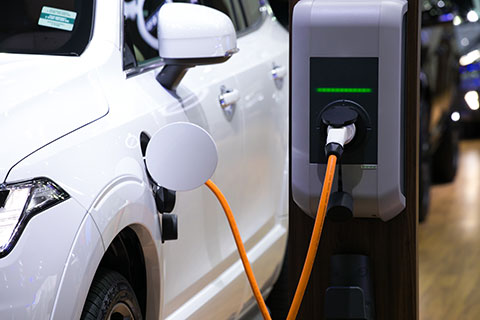
Electric Vehicles are Gaining Popularity Globally
In addition to many new features inside vehicles to help drivers, or replace them, there is a major revolution underway in the core powertrains that drive the next generation of automobiles and trucks. This rise of Electric Vehicles (EVs) is being hailed as a major step away from dependence on fossil fuels and alleviation of detrimental environmental impacts. However, it also requires a major overhaul in the underlying powertrain technologies and the electronic building blocks that enable EV functionality.
Acceleration of the EV Market
The worldwide EV market continues to see a high growth rate in all regions, reaching over 1 million units shipped in 2017 and poised for even faster growth going forward. According to McKinsey research, under the current growth trajectory, EV producers could almost quadruple that achievement by 2020, moving 4.5 million units, around 5% of the overall global light-vehicle market.
BloombergNEF extends predictions out even further. According to their EV forecast 2018, sales of EVs are predicted to increase from a record 1.1 million worldwide in 2017 to 11 million in 2025, and then surging to 30 million in 2030 as they become cheaper to make than internal combustion engine cars. China will lead this transition, with sales in the region accounting for almost 50% of the global EV market in 2025.
BloombergNEF extends predictions out even further. According to their EV forecast 2018, sales of EVs are predicted to increase from a record 1.1 million worldwide in 2017 to 11 million in 2025, and then surging to 30 million in 2030 as they become cheaper to make than internal combustion engine cars. China will lead this transition, with sales in the region accounting for almost 50% of the global EV market in 2025.
Key Technology Building Blocks for EV Success
From a technology standpoint, the enablement of EVs requires some fundamental shifts in the underlying capabilities, especially with regard to power inverter devices, battery subsystems and high-current busbar connectors. In addition to these core powertrain-related arenas, the shift towards EV systems also requires tight integration of many other functions, such as acceleration sensors, wheel sensors, braking functions, just to name a few.
Power Inverters
Power inversion occurs in many areas to support the electrification of various subsystems in vehicles— the most obvious being the high-voltage inverter system that typically supports the powertrain, which is sometimes termed as the “traction inverter”. Concurrently, low voltage inversion can be found in other domains such as steering and pumps.
Regardless of voltage level, all require some level of inversion from DC to AC voltage to drive the fields within the motors. Moreover, many of the challenges remain similar, such as how to integrate all the functions and associated subassemblies needed for current inversion into the smallest possible package with electrically efficient short path interconnects.
Conventional designs focused less on tightly integrating functionality, with most design approaches consisting of multiple discrete assemblies such as: Power DBCs, Capacitor Modules, Control Printed Circuit Boards (PCBs), and Multiple Bus Assemblies. These were connected by a variety of methods including: numerous wire-bonds, bolts, bus structures, harnesses, connectors, and solder-joints. The result was typically large, bulky and heavy power devices that exhibited high inductance and relatively low efficiency– all at a fairly high cost.
To support EV requirements, new-generation inverters need advanced interconnect and mechatronics solutions to maximize efficiency and optimize size and cost by tightly integrating all of the functionalities above into small-footprint inverters with compact pluggable sub-assemblies.
Regardless of voltage level, all require some level of inversion from DC to AC voltage to drive the fields within the motors. Moreover, many of the challenges remain similar, such as how to integrate all the functions and associated subassemblies needed for current inversion into the smallest possible package with electrically efficient short path interconnects.
Conventional designs focused less on tightly integrating functionality, with most design approaches consisting of multiple discrete assemblies such as: Power DBCs, Capacitor Modules, Control Printed Circuit Boards (PCBs), and Multiple Bus Assemblies. These were connected by a variety of methods including: numerous wire-bonds, bolts, bus structures, harnesses, connectors, and solder-joints. The result was typically large, bulky and heavy power devices that exhibited high inductance and relatively low efficiency– all at a fairly high cost.
To support EV requirements, new-generation inverters need advanced interconnect and mechatronics solutions to maximize efficiency and optimize size and cost by tightly integrating all of the functionalities above into small-footprint inverters with compact pluggable sub-assemblies.
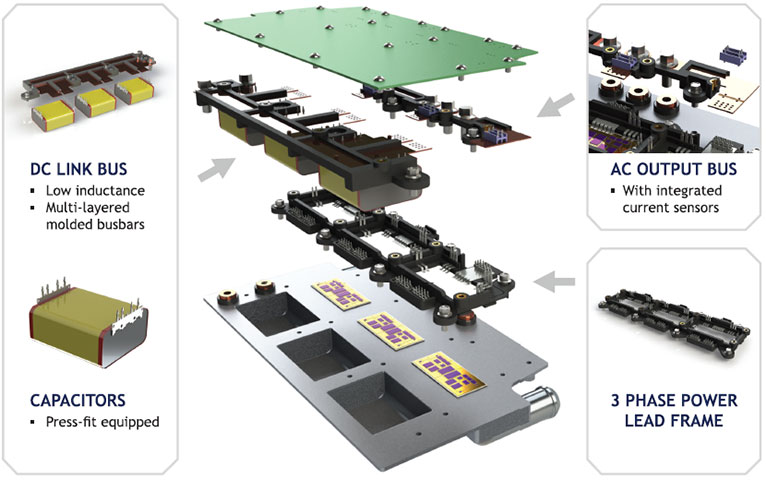
Customizable Mechatronics Packaging and Reliable Interconnect Solutions are Critical for Modern Power Applications
Battery Interconnect Systems
Creating cost-effective and well-integrated battery arrays is also critical to the overall success and competitiveness of new EV designs. As with power inverters, the best approach to battery systems is to step back and take a holistic approach to overall integration.
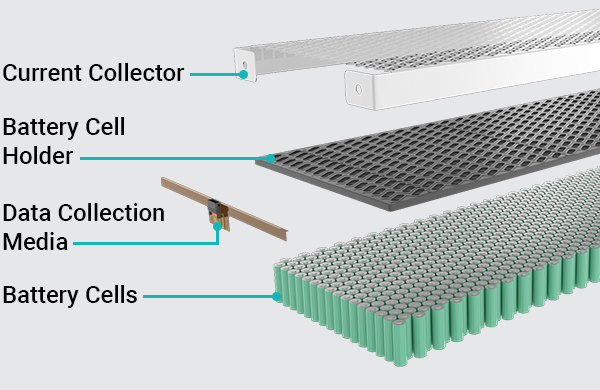
Interplex’s Cell-PLX™ EV Battery Interconnect System
As shown above, this entails close attention to the connectivity issues for flexibly combining multiple battery cells within an array as well as connecting the array to the EV drivetrain functionality. The careful design of lead frames, insulation layers, busbars, overmolding and interconnects helps to make next-gen EV battery systems more space-efficient and power-efficient as well as less costly.
Flexible Solutions for Busbar Integration
In power-intensive applications such as EV systems, busbars are a critical element for conducting significant current levels between functions and assemblies. Conventional methods for busbar attachment such as bolting, welding, or clamping are not always feasible as new-gen EV power applications get smaller and more complex. Also, soldering can be problematic because a busbar’s heat dissipation may not be compatible with mainstream automated assembly processes, instead requiring specialized secondary manual soldering steps. Soldering can be time consuming, costly, and exposes populated systems to the heat of secondary soldering processes.
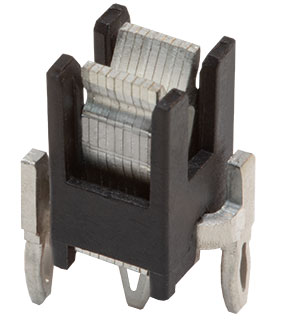
BusMate™ Power Busbar Connector
New BusMate™ power busbar connector technology provides a small footprint, high-current solution to minimize PCB real estate usage and improve design flexibility, while delivering excellent electrical interface characteristics. By enabling a configurable, compact, solderless and pluggable interface for connecting busbars, this technology gives engineers a highly reliable and assembly-friendly solution for implementing new EV power designs economically.
Key features include:
Key features include:
- Compact size: 8.4 x 6.0 x 9.9mm
- Excellent ampacity-size ratio
- Accommodates large assembly tolerances: ±0.8 mating blade offset, twist or insertion depth
- Customizable and scalable for higher currents
- High temperature construction: 125°C
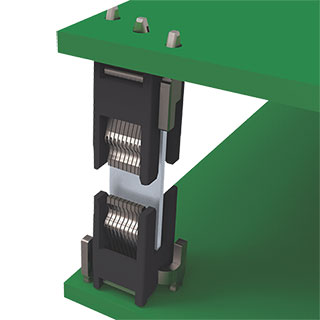
BusMate™ is Busbar Pluggable and Uses Press-Fit Technology to PCB

BusMate™ Accommodates Large Assembly Tolerances
Summary
As the global EV market continues to accelerate, vehicle manufacturers need to rely on an evolving supply chain of targeted solutions that offer the performance, reliability and configurability to support rapid design and introduction of new developments, all while keeping costs competitive.
The technology areas described above: 1) power inverters, 2) battery interconnect systems, and 3) high-efficiency busbar interconnects, represent critical enabling solutions that vehicle makers can apply across a wide range of EV implementations.
The technology areas described above: 1) power inverters, 2) battery interconnect systems, and 3) high-efficiency busbar interconnects, represent critical enabling solutions that vehicle makers can apply across a wide range of EV implementations.
Find out more about our Energy and Power solutions.




